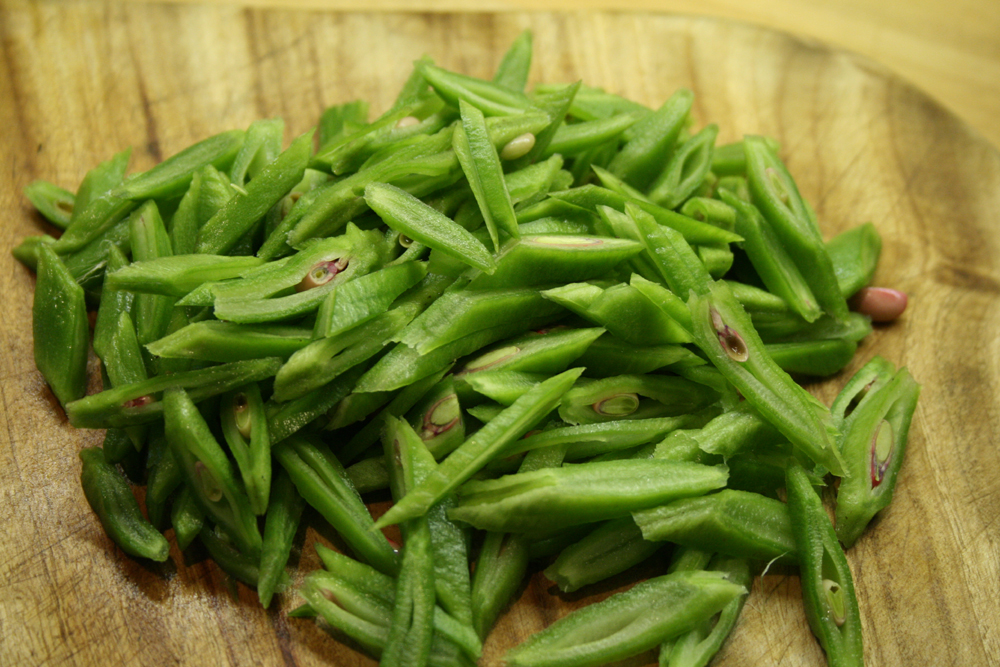
A different way with runner beans from Sarah Raven’s Garden Cookbook. She calls it ‘a delicious soft, creamy dish that is good with roast chicken. It also makes a tasty quick pasta sauce.’ If you don’t have savory, you can use thyme instead.
Serves 4
Preparation/cooking: 20 minutes
Ingredients
450g runner beans
salt and black pepper
150ml double cream
1 garlic clove, peeled
1 tbsp chopped summer savory or thyme, plus more to serve
grated parmesan cheese, to serve
Method
String and slice the beans and cook them uncovered in rapidly boiling salted water for 3 minutes until they are just tender. Plunge into cold water and drain.
Put the cream, garlic clove and savory or thyme in a saucepan. Add salt and pepper. Bring to the boil and simmer gently for 2 minutes. Remove from the heat and leave for 10 minutes for the flavours to merge. Take out the garlic.
Add the beans, put back on the heat and stir to heat them through. Scatter more savory or thyme and plenty of parmesan over the top.
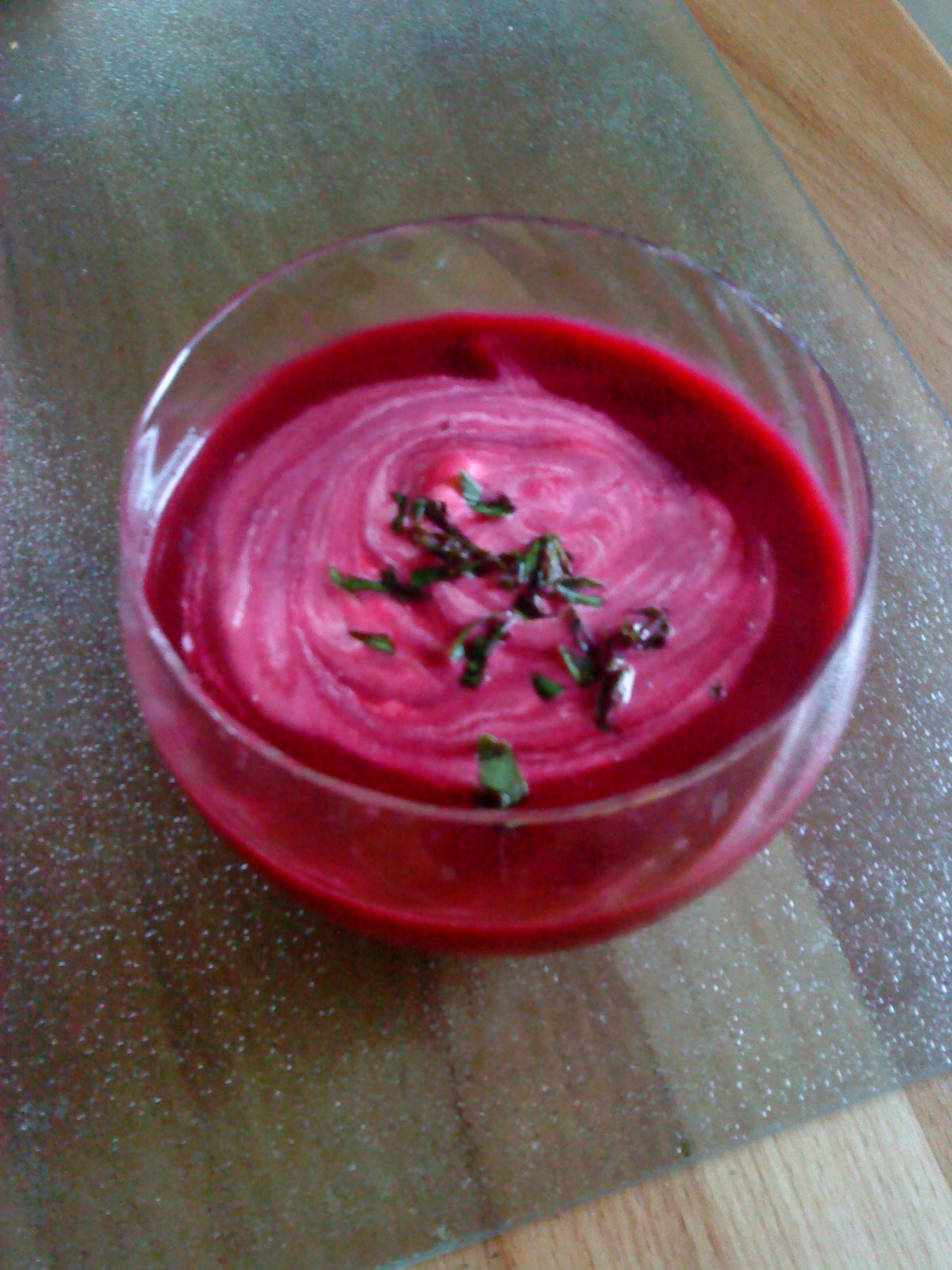
This summer soup recipe from Hugh Fearnley Whittingstall in The Guardian was served by Camel CSA member Anne Sadler at our Big Lunch.
Collective verdict? Delicious, but go easy on the vegetable stock as its taste could overpower the beetroot. Hugh says: “Roasting the beetroot adds a greater depth of flavour. The tartness of the sour cream is great with the sweet, earthy soup.”
Serves 4-6
Preparation / cooking: 45 minutes + 1 hour to roast the beetroot
Ingredients
550g beetroot
4½ tbsp olive oil
2 bay leaves
2 thyme sprigs
4 garlic cloves, 2 unpeeled and bashed, 2 peeled and minced
1 onion, diced
1 small carrot, diced
800ml good vegetable stock
4 tbsp sour cream
Salt and freshly ground black pepper
Fronds of dill, to garnish
Method
Give the beetroot a scrub, but leave the roots and part of the tops attached. Toss in a roasting pan with three tablespoons of olive oil, the bay, thyme sprigs and the bashed, unpeeled garlic, cover tightly with foil and roast at 200C/400F/gas mark 6 for 60-75 minutes, until you can pierce them easily with a knife. Leave to cool slightly, then peel (the skins should just slip off) and chop into 2.5cm cubes.
Warm the remaining oil in a saucepan over a medium-low heat and sauté the onion until soft, for around 15 minutes, add the carrot and sauté for a further five minutes. Add the beetroot and garlic, stir for a minute or two, then add the stock. Simmer for 20 minutes, set aside to cool a little, then purée until very smooth. Thin with a little stock or water if too thick, taste, season, cover and chill for at least four hours or overnight – it’s even better served the day after you’ve made it.
To serve, ladle the soup into bowls and serve with a swirl of sour cream and a sprinkling of dill.
More beetroot soup recipes from Hugh Fearnley-Whittingstall:
Beetroot soup with feta
Beetroot and cumin soup with spiced yoghurt
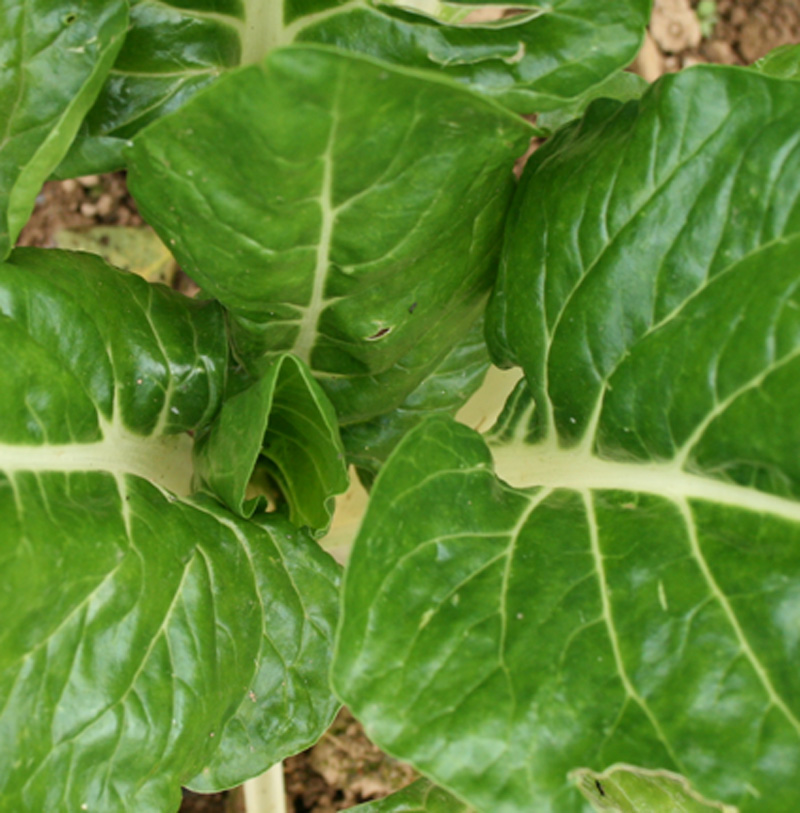
A recipe from Allegra McEvedy, who says: “The best thing about this simple supper is the chard … You can use it anywhere you might use wholeleaf spinach, but you will get a more boldly textured result. Chard is even better for you than spinach, too – it just never had the PR muscle of Popeye behind it. It contains less oxalic acid than spinach, which means that we are able to absorb more of its nutrients.”
Apologies to CSA members with small veg boxes who had perpetual spinach rather than Swiss chard this week! Still good for you, though.
Apparently, the Swiss prefix came about in the 19th-century to distinguish it from French chard, which we now call cardoon.
Serves 2
Preparation/Cooking: 30 minutes
Ingredients
150g brown rice
250g Swiss chard (big whole leaf spinach will do)
1 lemon
1 clove garlic, finely chopped
extra virgin olive oil
2 free-range chicken breasts
150g ball of mozzarella
1 ripe tomato
big pinch dried oregano
salt and pepper
Method
Rinse the rice in cold water, then tip into a saucepan with twice the volume of cold water. Bring to the boil, then simmer gently until cooked – about half an hour.
Meanwhile, put a second pan on with salted water for blanching the chard.
Trim and chuck away the very ends of the chard stalks, then cut the stalks away from the leaves. Slice the stalks into 2cm-thick pieces and leave the leaves whole. Blanch the stalks first for about three minutes, then remove from the pan with a slotted spoon, cool under running water and set aside. Now blanch the leaves for three minutes, rinse under cold water and set aside separately from the stalks.
Zest the lemon and put it with the chard stalks.
In a bowl, mix the garlic with the juice of half the lemon, a couple of tbsp of the olive oil and some seasoning. Squeeze the water out of the chard leaves and coat them thoroughly in the flavoured oil.
Oil a baking tray and pre-heat under a very hot grill. Make a cut down the length of the chicken breasts, but not all the way through so that they open up like a book (this is called butterflying for obvious reasons).
Season the meat, then lay on the dressed chard leaves. Top with slices of mozzarella and tomato, and finish with a little salt and the oregano.
Grill for 10-12 minutes. When the rice is cooked, stir in the chard stalks, some salt and a good splosh of olive oil and serve with the chicken on top.
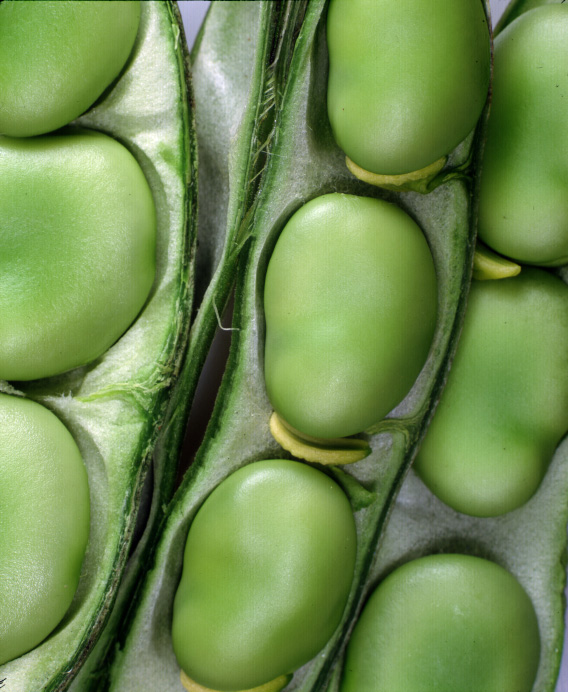
You either love ’em or loathe ’em. Fortunately some of us really do love them.
Broad beans are best eaten when they’re small and succulent. If you’re faced with some mealy monsters, boil or steam them as normal then “double pod” them by slipping the skins off the cooked beans. Fiddly but worth it.
My favourite ways with broad beans are short and simple. Cookery writer Nigel Slater offers a number of unfussy suggestions suitable for both meat-eaters and vegetarians. These come from his books The 30-Minute Cook and Real Fast Food.
1. Broad beans with bacon
Serves 2 as a main dish
Preparation: 10 minutes
Cooking: 15 minutes
450g shelled broad beans
1 tbsp olive oil
100g bacon, diced
freshly ground black pepper
A dish to eat with a bottle of beer. Drop the beans into a pan of boiling salted water and blanch for no more than 10 minutes. Warm the olive oil in a frying pan and fry the diced bacon until it starts to crisp at the edges. Drain the broad beans and add them to the bacon with a light grinding of pepper. Stir well and then cover with a lid. Cook for 5 minutes until the beans are absolutely tender.
2. Broad bean, bacon and Feta salad
The saltiness of the bacon and Feta cheese is toned down by the mealy broad beans. Cook the shelled beans in salted water till tender, about 10 minutes, and then drain and toss them with hot, crisp grilled bacon and roughly chopped and crumbled Feta cheese. Good with a beer.
3. Broad beans and goat’s cheese
Broad beans and goat’s cheese are an extraordinarily good combination. It was Claudia Roden who first brought them to my attention in her book, The Food of Italy. Ms Roden adds the shelled beans to chopped onion fried in olive oil, then simmers the two with water until very tender, drains them and serves them with cheese warmed under the grill.
I have also cooked the beans in boiling water till tender, drained and placed them in a shallow gratin dish. Then I covered them thoroughly with slices of cheese cut from a goat’s log and popped them under the grill until the cheese had just melted. Eaten with crisp French bread it made a delightful lunch.
This time Nigel suggests a bottle of cold, dry white wine. I’m with him on that one.
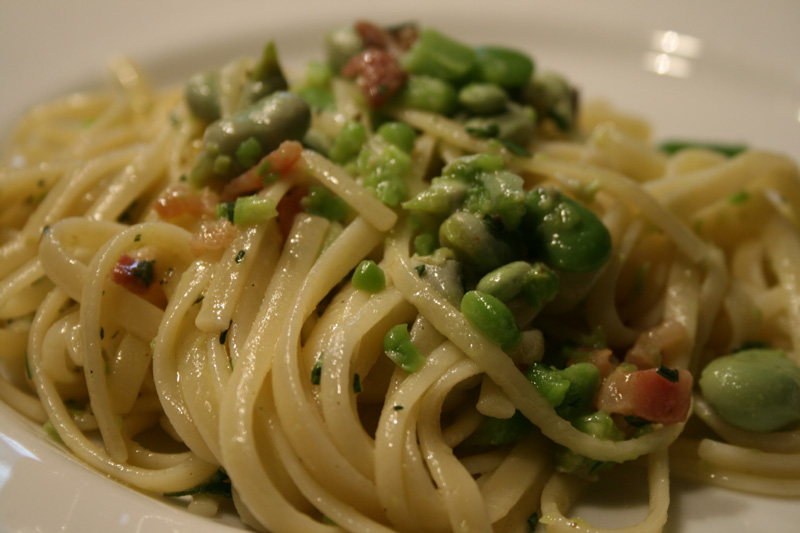
As this week’s boxes contained the produce from the Camel CSA’s two rows of broad beans which were picked clean this morning, it’s perhaps the last chance for a broad bean recipe. This is from Sarah Raven’s Garden Cookbook. She recommends using tagliolini or fine spaghetti. Slightly fiddly recipe but the result is very tasty.
Serves 4
Preparation: 10 minutes
Cooking: 15 minutes
Ingredients
250g broad beans, shelled weight
350g tagliolini or fine spaghetti
75g fried pancetta or prosciutto
2 tbsp finely chopped summer savory or thyme, to serve
grated parmesan cheese, to serve
For the beurre blanc:
4 tbsp white wine
4 tbsp white wine vinegar
1 heaped tbsp finely chopped shallots
salt and black pepper
175g unsalted butter, cold and diced
Method
To make the beurre blanc, reduce the wine, vinegar, shallots, salt and pepper in a small saucepan until you have only a tablespoon of liquid left. Whisk in the cold butter bit by bit over a very low heat or using a bain-marie, until thick and creamy. Season. Keep it warm in a vacuum flask or bain marie.
Bring a pan of water to the boil. Cook the beans in the water for 4 minutes. Remove them, reserving some of the cooking liquid, and cool them quickly in a sieve under cold running water.
Pop some of the bright green beans out of their skin by pinching them with your thumb and forefinger; this adds a wonderful colour. Discard the skins and puree half the beans with a tablespoon of the cooking water.
Cook the pasta in salted boiling water until just al dente, leaving a tablespoon or two of cooking liquid in the pan. Add the bean puree, pancetta or prosciutto and the beurre blanc, and stir. Season carefully.
Lastly throw in the remaining beans and stir. Serve with summer savory or thyme and grated parmesan.
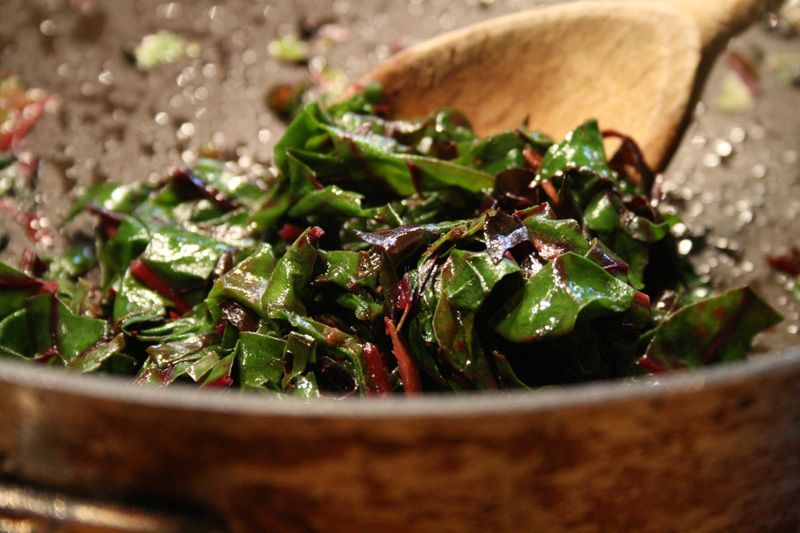
A recipe from Sarah Raven’s Garden Cookbook which she says came from Madhur Jaffrey’s World Vegetarian. A good way of using those beetroot leaves and a nice change from chard or spinach.
Serves 4
Preparation: 5 minutes
Cooking: 10 minutes
Ingredients
450g beetroot greens
3 tbsp vegetable oil
1 fresh green chilli, cut into long thin slivers
3cm piece of fresh ginger, peeled and cut into long slivers
½ tsp salt
Method
Strip the beetroot greens from the stalks and cut them into fine ribbons.
Put the oil in a large pan and warm over a high heat. When the oil is hot, put in the chilli and ginger. Stir them around for a minute and then add the greens.
Cover the pan, turn the heat to low and cook until the leaves have wilted. Add the salt and stir, then add 4 tbsp water and bring to a simmer.
Cover again and cook on a low heat, stirring occasionally, until the greens are tender.
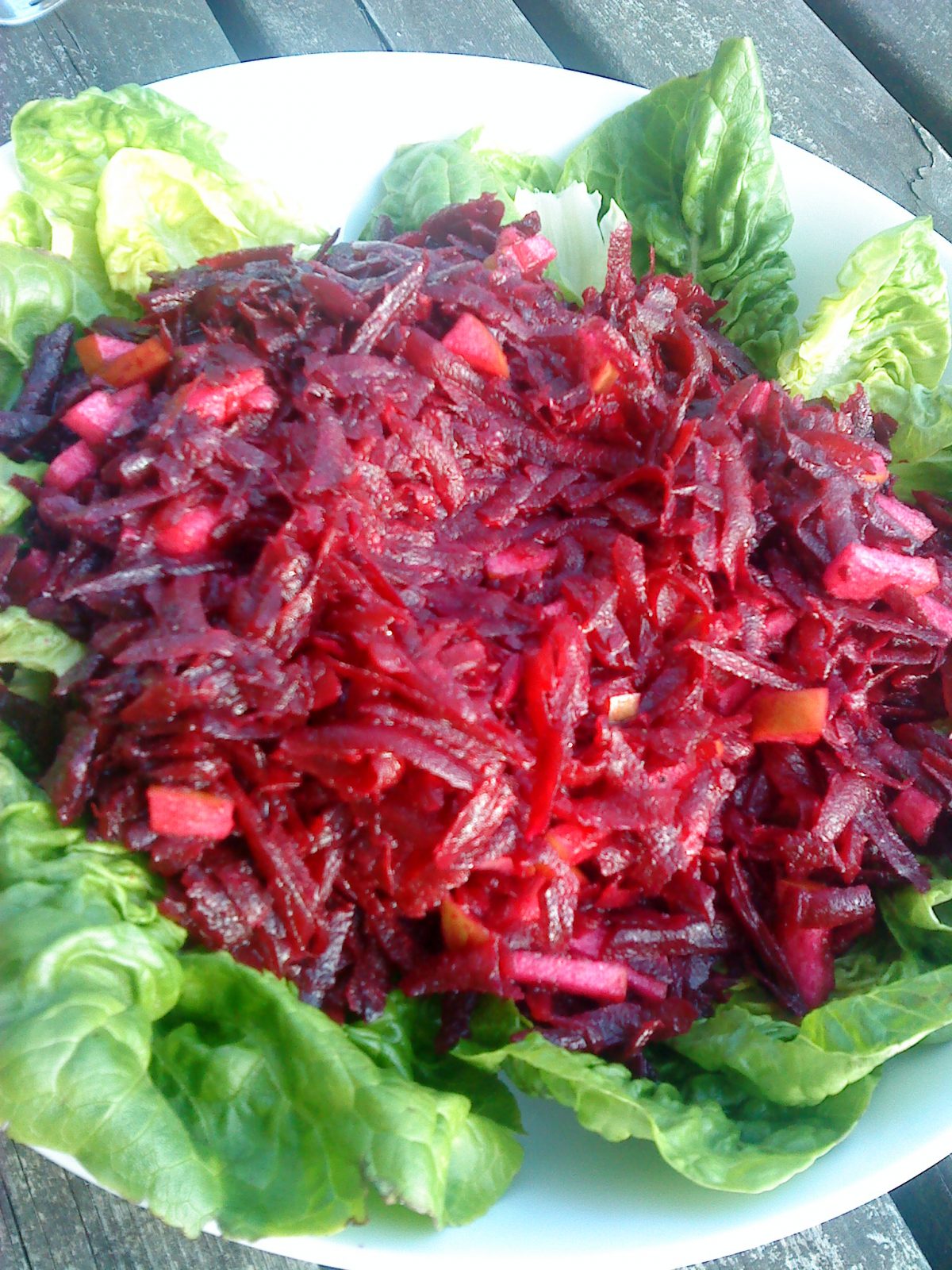
This quick and refreshing salad is ideal for people who don’t like the after-taste of raw onion. It comes from a useful little book called Seasonal Salads by Paddy Byrne and David Scott, founders of the renowned Everyman Bistro in Liverpool. “Raw beetroot and cooked beetroot have very different flavours and texture and this salad cleverly makes use of both,” they say.
Serves 4
Preparation: 10 minutes
Cooking: 40-45 minutes
Ingredients
1 large cooked beetroot (or several small ones) peeled and grated
1 large raw beetroot (or several small ones) peeled and grated
1 large eating apple, cored and cut into thin matchsticks
juice of half a lemon
5ml (1 tsp) grated lemon peel
25ml vegetable oil
salt and black pepper to taste
Method
Reserve a little of both types of beetroot and mix the remainder with the apple. Add the lemon juice, oil and salt and pepper to taste and toss the salad. Mix the lemon peel with the reserved beetroot and use it to garnish the salad.
Variation
Those people who don’t care for the taste of raw beetroot could try it with just par-boiled beetroot. Cook raw beetroot in plenty of water until the outer skin will just rub off. Now drain them and cool under running water until they are quite cold. The centres remain bright red and crisp while the outer areas are softer and a darker ruby red. Grate the beetroot and continue as directed in the recipe.
Try these other beetroot dishes from Camel CSA’s recommended recipes.
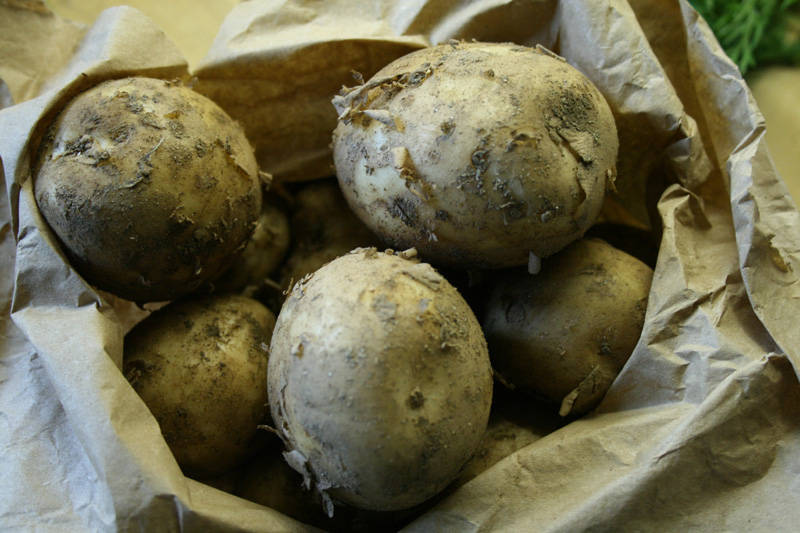
Thanks again to Henrietta Danvers for this week’s recipe – a Good Housekeeping one that makes good use of the new potatoes in our boxes.
Serves 2
Preparation: 5 minutes
Cooking: 25 minutes
Ingredients
250g new potatoes
salt and pepper
1 small onion, chopped
125g bacon, diced
2 tbsp olive oil
125g button mushrooms
125g Cheddar cheese, grated
Method
Cook the potatoes and drain. Heat the olive oil and cook the onion and bacon, then add the mushrooms. Transfer to a gratin dish and stir in the potatoes. Season and spread the grated cheese on top. Grill until the cheese is bubbling. Serve.
For a vegetarian variation, replace the bacon with sliced leeks and add fresh herbs such as thyme and a little rosemary.
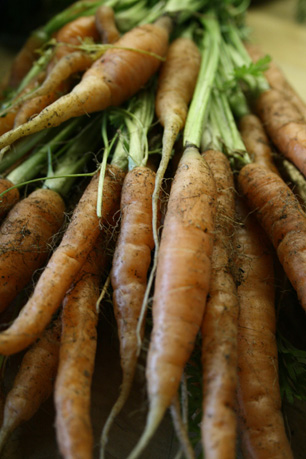
A simply delicious way of cooking new-season carrots from Henrietta Danvers, one of Camel CSA’s picking and packing volunteers.
Serves 6
Preparation: 10 minutes
Cooking: 15 minutes
Ingredients
750g baby carrots, tops off
2 sprigs of fresh thyme, chopped finely
Juice of half a lemon
25g butter
500ml vegetable stock
Method
Scrub the carrots and leave them whole. Bring the stock to the boil in a heavy-bottomed pan, then add the butter and lemon juice. When the butter has melted, add the whole carrots and cook for five minutes. Take out the carrots with a slotted spoon and pour some of the liquid into another container (keep for soup). Retain about 1ml of stock in the bottom of the pan and reduce it over a high heat. Pop the carrots back into the pan to coat them with the remaining liquid. Sprinkle on the chopped thyme leaves and serve.

Update
Glad we agree on this one: Hugh Fearnley-Whittingstall’s cookery column in the Guardian this weekend features – guess what – new-season carrot recipes. “There’s not much that heralds the onset of summer as much as a new-season carrot – so get grating, chopping, roasting, even baking now,” he says.
We will, Hugh, we will…
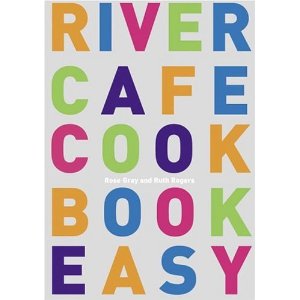
This is a perfect creamy pasta dish that uses some of the fresh basil we have in the veg boxes this week. It comes from the first River Cafe Cook Book Easy, whose authors are the late-lamented Rose Gray and her fellow River Cafe founder Ruth Rogers.
Serves 4
Preparation: 10 minutes
Cooking: 30 minutes
Ingredients
350g dried egg tagliatelle
100g pancetta
500g cooked borlotti beans (or tinned)
1 red onion
2 garlic cloves,
1 x 400g tin of peeled plum tomatoes, drained
3 tbs double cream
3 tbs torn basil leaves
50g Parmesan, freshly grated
extra-virgin olive oil
Method
Peel and chop the onion and the garlic. Cut the pancetta into 1cm pieces. Rinse the beans if tinned.
Heat 2 tbs of olive oil in a thick-bottomed pan. Add the onion and cook until soft, then add the garlic and pancetta and cook until the pancetta is translucent. This should take about 10 minutes. Add the tomatoes, chopping them up to make a sauce, and cook for a further 10 minutes.
Season, then stir in the borlotti beans and cream. Cook for 5-10 minutes, until the sauce is thick. Add the basil and 2 tbs of olive oil. Cook the tagliatelle in boiling salted water until al dente. Drain, retaining 3-4 tbs of the pasta water. Add the tagliatelle to the beans, adding the retained pasta water if the sauce is too thick. Toss together, drizzle with olive oil and serve with the Parmesan.


